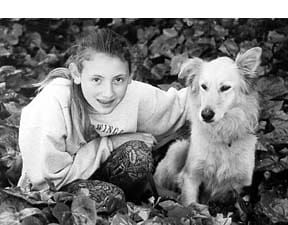So you want to adopt an older dog. Rescue a homeless hound. Save a life. Fantastic! Gone are the days when everyone wants to start out with a baby puppy – and that’s a good thing. In the last decade, as pet owners have become more responsible about spaying and neutering, shelters across the country have noticed a marked decrease in the numbers of puppies they receive.
Instead, they now find that the preponderance of homeless dogs in their kennels are adolescents – six months to two years old – who haven’t received the training and direction they needed to become good canine citizens. More and more of today’s two-career families, single parents, and career singles are realizing that they don’t have the time and energy required to raise a puppy properly (see “Getting Off to the Best Start,” WDJ January 1999), deciding instead to join the growing numbers of pet owners who opt to experience the rewards of giving an older dog a second chance for a lifelong loving home.
Adopting a “recycled” dog makes a lot of sense. He may already be housebroken. Even if he’s not, he’s physically mature enough to learn quickly. He may be past the puppy chewing stage, so you might not need to be as diligent about keeping valuables out of reach of his jaws. He’s probably full grown, or close, so you know that “what-you-see-is-what-you-get;” no surprises when the puppy that the shelter staffers deemed to be a “Chihuahua-mix” turns into a 60-pound Lab/Pit Bull. He may even have had some training and be the perfect canine companion already.

But don’t count on it. Dogs don’t generally end up at animal shelters and rescue organizations when they are well-behaved, well-loved family pets.
Families don’t usually look for new homes for dogs that are perfect canine companions. There are exceptions, of course, but chances are good that the furry face gazing beseechingly at you from behind the chain-link kennel comes with a package of behavior challenges that may take some considerable effort to turn a “Tramp” into a “Trooper.”
Don’t get us wrong; we’d be the last people on earth to discourage you from adopting a shelter or rescue dog. We just want you to know what you’re getting into, to help you choose wisely, to make sure you have reasonable expectations for your new companion, and to give you some tips for making Trooper’s transition to your home a smooth and pleasant one.
Choosing your dog
Walking into a shelter to select a dog can be a daunting task. How can you possibly pick one, from among all the dogs waiting for a home? You can, if you prepare in advance. You need to make a list of the qualities that you are looking for in a dog, take the time to evaluate your adoption prospects carefully, and be firm in not letting your heart rule your head. Remember, the dog you adopt will be a member of your family for a good 10 to 15, maybe even 20 years. With all the dogs out there that need homes, you might as well choose one that will fit into your environment and lifestyle; one that will give you 15 years of joy, not a decade-plus of headaches and heartaches.
Before you set foot in a shelter or answer an ad in the paper, have your list ready. Your list should have three columns: Must Have; Would Like to Have; and Won’t Have. Spend several days or weeks creating this list, with input from the entire family.
Items in the “Must Have” column might include: female, short-haired, under 40 pounds, good with kids. Would Like to Have attributes might include: already house-trained, rides well in cars, walks well on a leash. Won’t Have’s might include: jumps up, runs away, bites, chases cats.
When you go to visit adoption prospects, take your list with you, and make sure you don’t compromise anything that the family has agreed is a Must Have or a Won’t Have. Be firm! It’s easy to weaken in the presence of an adorably fuzzy face, but you will regret it if “housebroken” was one of your “Must Have’s” and Fluffy goes home and pees all over your Oriental carpets.
Evaluating your prospect
Your local shelter may or may not perform temperament evaluations and provide “personality profiles” for their adoption dogs. Whether they do or not, it’s best if you are prepared to conduct your own temperament evaluation. The easiest way to do this is to observe the dog closely while he is given relative freedom in an exercise yard or other open space, like a large room, and grade him as more of one quality than the other in a series of compared behaviors.
Turn the dog out in the exercise yard and leave him alone for five to 10 minutes or so. This will give him time to empty his bladder and acquaint himself with his surroundings. You will get a truer picture of his real self if you give him time to settle down before you start interacting with him. If you can, watch him from out of his sight during this time. Does he pace the fence, looking for weak spots and measuring the top with a practiced eye? You may have an escape artist in the making. Does he sit by the gate and howl mournfully the entire time, or dig frantically to get back in the door? You might be looking at separation anxiety, or at least at a dog who doesn’t do well being left alone. These are helpful things to know, especially if neighbors are going to be upset by an eight-hour serenade while you are at work.
When you step back into the exercise yard with Trooper, note his response. Does he ignore you and continue his doggie explorations of the yard? He is probably somewhat independent and not very “people centered.” You may need to work hard to win his loyalty. Does he bowl you over in his eagerness to greet you? He may be very people-centered, but perhaps too rough, fractious, and demanding for a home with small children. Is he happy to see you but careful not to make body contact? He may be calm, gentle, well mannered, and amiable – perhaps one of the rare, ready-made shelter gems.
If you have children, you should also do a careful “sensitivity test,” by gently pinching the thin skin of his flank. His reaction may range from ignoring you (a good response for a child’s dog) to bumping you with his nose or even snapping at you. Since a child’s dog needs to be tolerant of occasional or accidental inconsiderate behavior, you want your child’s dog not to overreact to a sensitivity test.
The dog’s reaction to a “startle test” might also be instructive. For this test, wait until the dog is looking away from you, then make a loud noise – stomp on the floor, yell “Hey!,” clap your hands – anything that will startle him. A confident dog will ignore the noise, or react but recover quickly. A dog that is slow to recover from the startle test may make a fine pet, but is probably not a good choice for a child’s dog. (Do not do this test with puppies between the ages of 8-18 weeks. Puppies go through a “fear” period where they can be very adversely affected by being startled or frightened.)
Finally, if you do have children, the dog must meet them and love them before you make a final adoption decision. Indifference won’t do – the dog has to “dig” kids or you will have problems.
Once you have completed your evaluation, compare your notes and your list. Does Trooper meet all of your “Must Have’s?” Does he miss all of your “Won’t Have’s?” Does he have a fair smattering of your “Would Like’s?” If so, now is the time to let the heart play its role. Do you already love him? Does the thought of leaving him at the shelter make your stomach hurt? Can you see yourself taking him for walks in the pouring rain and driving snow for the next 15 years – and smiling? Then you may have found your dog.
Be sure to evaluate more than one dog, even if you’re sure Trooper is your soulmate. Comparison with a few other dogs will give you a healthy perspective on his behaviors, and make you more confident about your final decision.
Taking Trooper home
You have leaped through all the shelter adoption hurdles like an Olympic athlete, and you and Trooper are headed home. Hopefully, you prepared “home” in advance.
We tend to assume that all grown-up dogs have grown-up manners – and assumptions can be dangerous. Trooper may have been kept in the back yard at his last home, and doesn’t know that it’s not polite to lift his leg in a house. His first family may have tossed old shoes into the yard for him to chew on, so when he heads straight for your $130 Nikes, he won’t have a clue that he’s doing anything wrong, and he will be confused and perhaps frightened, when you yell at him for shredding your sneakers.
Your best approach is to assume he knows nothing, and to make a cautious introduction into the house. Remove all valuables from dog reach before you bring Trooper home. Bring him in on a leash. Watch his body language. Does he seem comfortable in the house, or does he act like he thinks he’s not supposed to be there? Does he negotiate thresholds easily? Does he seem to respect surface boundaries, or is that ham sandwich on the counter in danger? Does he want to put his mouth on everything within reach, or does he politely focus on the several inviting toys you have provided for him? You can start his training immediately by saying “Yes” or clicking a clicker, and feeding him a small, tasty treat for any acceptable behaviors. If he walks in the house and sits politely or lies down on a rug, that’s a definite “Yes!” and treat.
The best way to deal with potential unwanted behaviors is to prevent them, just as you would with a puppy. The first few days are critical. With Trooper still on leash, watch for any signs of unwanted behaviors.
If, for example, he starts getting too cozy with the corner of the sofa, sniffing with interest and angling his flank toward it, use a gentle “Uh-uh, Trooper, over here!” and immediately take him back outside. Find a good leg-lifting spot, and when he does his thing, say “Go pee,” and then click the clicker or say “Yes,” and feed him a treat. (You are teaching him to eliminate on cue – a handy talent for any dog to know.)
For several days to a week or more he will need to have his freedom restricted in the house, until he learns that leg-lifting only happens outside. (If he is not already neutered, get this done immediately! Neutering will help immensely in diminishing his drive to lift his leg.)
Crates and tie-downs are also useful tools if you find that Trooper is not as well-mannered in the house as you had hoped. He can be crated all night, preferably in someone’s bedroom so he doesn’t feel isolated from the “pack,” and you can all get a peaceful night’s sleep without worrying about what he might be getting into. Crating also reinforces house-training, if he’s not solid on that vital skill. If Trooper is not already crate-trained, gently introduce him to the crate by tossing in treats and toys and letting him go in on his own. Once he’s comfortable going in and out, hold the door closed and feed him a few treats through the wires. Gradually get him accustomed to staying in with the door closed for longer periods. Most dogs, if introduced to their crates properly, come to love them. (For help with the crate-training process, see “Proper Crate Training,” WDJ August 1998.)
A tie-down is a short nylon-coated cable with snaps on both ends. It can be used to secure Trooper to something solid (a piano leg, sofa, or, best, an eye-bolt screwed into a beam) to keep him confined but still among the family. This is useful if he wants to join you at the dinner table, play tug-of-war during meditation time, or sit in guests’ laps without an invitation. Any undesirable behavior can win him a few minutes’ time-out, with a cheerful, “Too bad, Trooper, time-out!” and a short spell on his tie-down. This is not done in anger – he’s not a bad dog; he just needs a little quiet time. A soft bed at the tie-down location will keep him comfortable, and he will soon learn to stop the behaviors that result in this temporary restriction.
Your yard should be well-secured before Trooper is turned loose in it. Many dogs are at shelters because they have a history of running at large. Don’t take any chances on Trooper finding a weak spot and learning he can escape; having succeeded once, he will try much harder to get out again. If he never gets out the first time, your life will be much easier. Even if you’re sure your fence is solid, watch him closely the first few times he’s in the yard. If he tests the fence, you will need to keep watching him closely for several weeks, or until you see his testing behavior diminish. (Remember to reward him for calm, relaxed behavior in the yard.) If he seems to be succeeding in weakening a spot in the fence, excavating under, or scrambling over, you will need to take preventative measures before he makes the great escape.
On the other hand, if he seems perfectly comfortable hanging out in the back yard, you may be home-free. Just be careful if you plan to leave him outside when you go away; some dogs are fine when they have company, but get frantic about getting out when they are left alone. Test him by asking a neighbor to keep an eye on him while you leave. Drive to a nearby store and call in. If the neighbor reports that Trooper is still lying calmly under the oak tree, you win again. But if Trooper is panicked and clawing his way over the side gate, you’d better hustle back and find a different solution for leaving Trooper home alone.
A proper education
All dogs and owners can benefit from attending a good training class, and Trooper is no exception. Find a trainer in your area who offers classes using positive, non-forceful training methods. Not only will the training class help develop and improve the communication and understanding between you and Trooper, your trainer will be an invaluable resource to help work through any of Trooper’s behavior quirks that might be troubling you. (For help finding a good trainer, see “Choosing the Right Trainer,” WDJ May 1998, and “There’s More Than One Way,” WDJ July 1998.)
The great unknown
Bringing a dog home is bringing home an unknown quantity, even if you adopt directly from the previous owner; after all, people aren’t always honest about their dogs’ behaviors – you might not take the dog if they were! And most shelter dogs come with little or no information at all.
So, expect the unexpected. Maintain a sense of humor. Remember that dogs don’t do “bad” things out of spite or malice; they just do things that make them feel good! It’s not their fault if no one ever taught them that some things that make them feel good aren’t acceptable in a human “pack.” Like all living things, dogs repeat behaviors they find rewarding. Reward the behaviors that you want. Prevent, or to the extent possible, ignore, the behaviors you don’t want. If you are good at these two tasks, you will end up with a real Trooper.






